- Welcome to Victor Zheng's Website/
- Articles/
- Chess/
- What Toronto Chess Lacks and Solutions to Solve the Challenges/
What Toronto Chess Lacks and Solutions to Solve the Challenges
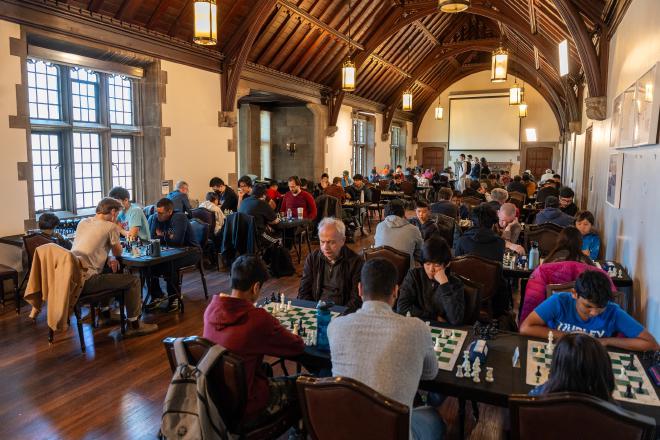
Table of Contents
Toronto chess has seen immense growth over the past few years but there’s still a lot more to go. There are tournaments nearly every weekend (see the CFC website), and many new and established organizers and clubs are eager for players to join. However, in conversations with organizers, players, arbiters, and officials across Toronto, I believe there are key areas we must improve. This post outlines the current structure, its challenges, and some proposed solutions.
How Toronto Chess Is Organized #
Chess Federation of Canada (CFC) #
The Chess Federation of Canada is the national body for chess in Canada. It operates similarly to Canada Soccer or Hockey Canada and is recognized by the Canadian Olympic Committee now that chess is considered a sport.
The CFC manages Canada’s FIDE relationship, rating system, national events, and international team selection. A paid Executive Director (currently based in Hamilton) oversees day-to-day operations. It also coordinates with regional bodies like Quebec’s FQE.
Ontario Chess Association (OCA) #
Beneath the CFC is the Ontario Chess Association, which distributes funding and oversees provincial tournaments like the Ontario Open and Ontario Youth Chess Championships.
Greater Toronto Chess League (GTCL) #
One of four regional leagues under the OCA, the GTCL represents the Greater Toronto Area. It organizes regional events like the Toronto Open, Closed, Rapid, and League Championships. The majority of Ontario’s chess players reside in this region.
Governors & Membership #
Governors are allocated based on provincial membership counts (1 per 50 members annually). In Toronto, these representatives are elected at the GTCL’s Annual General Meeting and serve on both the OCA and CFC boards. These boards help shape the direction of each of the organizations through regular meetings and voting.
To be a member of the GTCL, players must hold memberships in the OCA and CFC. Fees are collected nationally, then distributed accordingly. Ontario is unique in its use of regional leagues thanks to its large player base.
With nearly 100 governors nationwide, the GTCL routinely holds over 30 of these positions—demonstrating Toronto’s central role in shaping Canadian chess.
What Toronto Chess Does Well #
Opportunities to Play #
Every week, players can find rated, long time-control events through community clubs or weekend tournaments. There is a strong informal consensus to avoid scheduling conflicts, and even when they occur, multiple well-attended events often run in parallel. Weekly play can be found in all time formats and in all parts of the region on any given day.
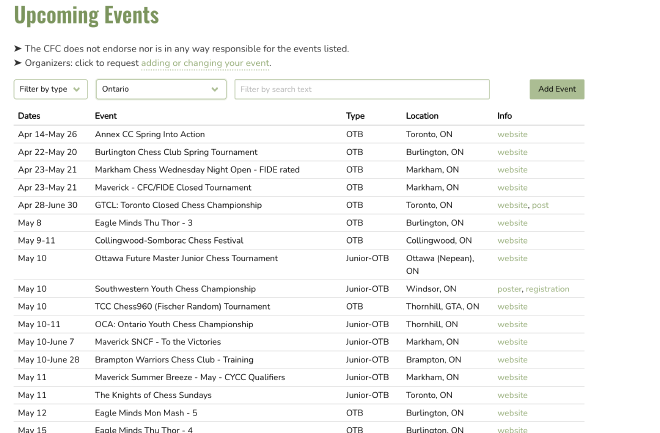 |
|---|
| Chess events across Ontario in early May 2025 |
Top Players #
Recent data visualizations I produced show that the majority of Canada’s National Masters live in the GTCL region. While this partially reflects the area’s population, it also highlights the depth of competitive chess in Toronto.
Proximity to major U.S. and international events may also play a role, along with the region’s consistent tournament offerings. This is an encouraging sign for the development of newer generations of players.
Organizers and Arbiters #
Ontario has the highest number of top-ranked organizers in Canada, many based in Toronto. The same is true for arbiters. Though the CFC only tracks a single arbiter per event, many tournaments here involve experienced teams, including senior arbiters mentoring newer ones. A positive cyclic-effect where knowledge is shared contributes to having some of the best regarded events, arbiters, and organizers in the nation.
Inclusion #
We have some of the most inclusive events in the world where anyone regardless of where they are from are welcome to play. In addition, all levels form beginners to masters show up to events. Toronto chess culture reflects the diversity and multiculturalism of the city.
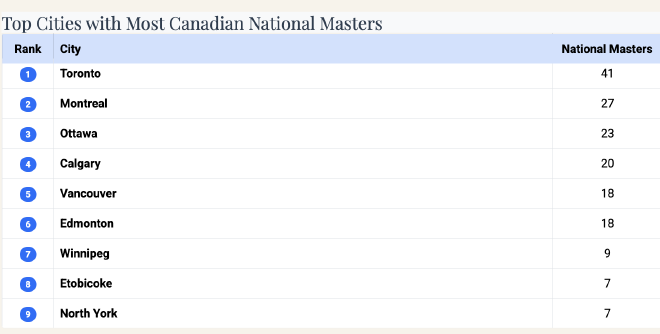 |
|---|
| Toronto leads in producing National Masters (source) |
What Toronto (and Canada) Misses #
Missed Online-to-In-Person Pipeline #
Over 300,000 players are registered on Chess.com with Canadian flags. If even 25% live in the GTA, that suggests 75,000 local players. Yet only around 5,000 Canadians played in-person tournaments in 2024 (source).
On average, just 2 in every 100 chess players in Canada played an in-person tournament last year.
Why Aren’t Online Players Showing Up? #
I’ve pondered this question for years. At Hart House Chess Club, we created a video series to ask this question and to help promote in-person chess:
What’s disheartening is how many University of Toronto students play online but never visit the club. Despite having top arbiters, excellent pricing, and a central venue with live DGT boards, attendance still falls short of what it could be. Clearly, we can do better.
Who Does Show Up? #
- Juniors: Often driven by parents who want their children to have a low-cost, low-barrier hobby. Equipment costs are minimal and the structure resembles other youth sports.
- Seniors: Retirees who love chess and regularly attend events. They need little promotion.
- Working Adults (18–50): The most underrepresented group. This includes university students and professionals. Many top players stop competing in their early 20s. Many adults attend once and don’t attend again. Why?
How do we attract adult players—and keep them engaged long term?
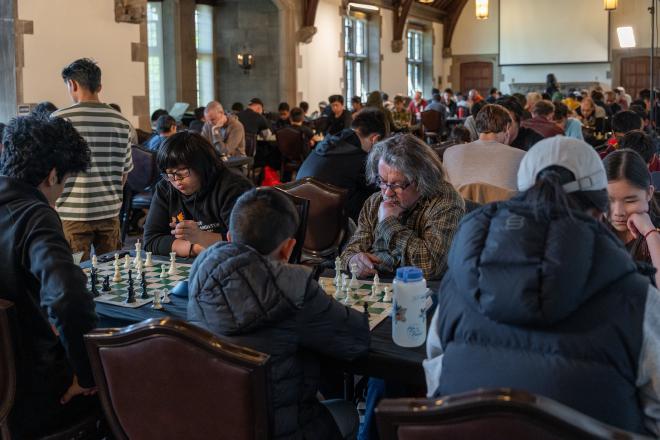 |
|---|
| A diverse group of chess players compete at the 2025 Toronto Rapid (photo by Jay Bhadreshwara) |
Lack of a Community Experience #
For many, chess tournaments are isolating. Long rounds, early starts, gaps between games—and no social engagement. The issue is compounded by:
Underrated Juniors #
Adults are often paired against juniors who are far stronger than their ratings suggest. After quickly demolishing their opponents, juniors often leave the board without a word. Adults, especially new players, feel demoralized and lose their motivation to study and play chess. No post-game analysis is conducted and adults oftentimes are left to wait for their next crushing defeat alone.
It’s no wonder that many new-players don’t return to a tournament.
Few Social Opportunities #
Adults are more likely to attend tournaments if friends are going. Post-game analysis, casual conversation, or simply having lunch together greatly enhances the experience. Yet many tournaments don’t provide space or incentive for that.
Organizers tend to prioritize logistics such as ensuring that boards, clocks, and pairings are completed—over player experience. That’s understandable, but it leaves a gap in long-term engagement.
We need to treat the chess experience as central—not just running a chess event but running an event that people want to come back for.
Solutions #
Better Communication #
We lack strong, consistent communication with the broader chess community. Here’s how to fix it:
- Maintain an up-to-date Toronto chess website
- Launch a monthly newsletter (like BCCF does)
- Include event photos, results, and upcoming schedules on the website
- Build a Toronto-wide club directory with images and locations
- Maintain an email mailing list of CFC members in the region (ideally supported by the CFC)
Let’s make this communication open-source. Host the website code on GitHub. Engage student developers from UofT Blueprint or similar groups to build and maintain it.
Help Adults Stay Involved #
Once adults show up, how do we keep them?
- Adult-only events (18+): Following the example of the Charlotte Chess Center, these events create space for camaraderie and continuity.
- Mini-communities: Encourage clubs and tournaments to facilitate player interaction through socials, team events, or analysis rooms.
- Event culture: Recognize that many players are looking for connection, not just competition.
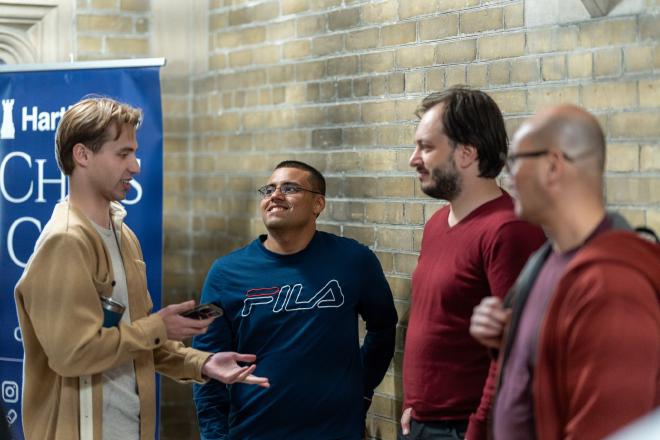 |
|---|
| We need to build more mini-communities and help encourage adults to stay involved (photo by Jay Bhadreshwara) |
The Long-Term Vision #
Toronto has all the ingredients to become a world-class chess city. But we need to invest in communication and community-building now.
My Commitment #
These challenges are why I’ve put my name forward to help. As a Director at Large of the Greater Toronto Chess League for 2025–2026, I’m working alongside our Communications Director to address these issues head-on.
I welcome our community’s ideas and collaboration as we shape the future of Toronto chess—together.